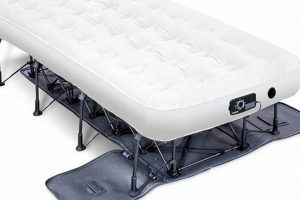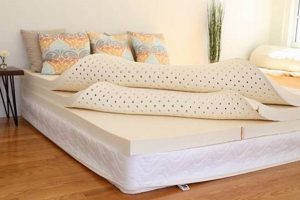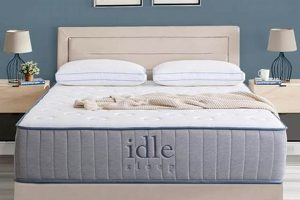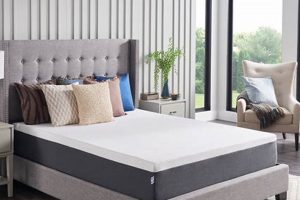The optimal sleep surface for individuals experiencing sciatic nerve pain is designed to minimize pressure points and promote proper spinal alignment. This type of mattress aims to alleviate discomfort radiating along the sciatic nerve, which runs from the lower back down the leg. For example, a mattress that contours to the body’s shape while providing adequate support can help reduce nerve compression during sleep.
Selecting an appropriate mattress is a significant factor in managing sciatica symptoms and improving sleep quality. Reduced pressure on the sciatic nerve can lead to decreased pain and inflammation, potentially minimizing the need for pain medication. Historically, people with sciatica were often limited to firm, unyielding mattresses; however, contemporary designs offer a broader range of options that balance support and comfort.
This article will explore the key considerations in choosing a mattress to alleviate sciatica. It will delve into mattress types, firmness levels, materials, and features that contribute to spinal alignment and pressure relief. Furthermore, the discussion will consider individual factors such as sleeping position and body weight, which influence mattress suitability.
Tips for Selecting a Mattress to Alleviate Sciatica
Choosing a suitable mattress can significantly impact the severity and frequency of sciatica symptoms. The following guidance offers crucial considerations when selecting a mattress designed to minimize nerve compression and promote spinal alignment.
Tip 1: Prioritize Spinal Alignment: A mattress should maintain the natural curvature of the spine. This prevents excessive pressure on the sciatic nerve roots in the lower back. A neutral spine position is essential, regardless of sleeping posture.
Tip 2: Evaluate Firmness Level: Firmness is subjective, but a medium-firm mattress is often recommended. This provides adequate support while allowing for some contouring to reduce pressure points. Individual body weight and sleeping position will influence the ideal firmness.
Tip 3: Consider Mattress Type: Memory foam, latex, and hybrid mattresses are popular choices. Memory foam conforms to the body, while latex offers a more responsive feel. Hybrid mattresses combine these materials with innerspring coils for enhanced support and airflow.
Tip 4: Examine Pressure Relief Properties: Assess how well the mattress distributes weight. Areas such as the hips and shoulders should be cushioned to avoid concentrated pressure on the sciatic nerve. Pressure mapping technology can provide insights into a mattress’s pressure relief capabilities.
Tip 5: Research Mattress Construction: Look for mattresses with multiple layers that provide both support and comfort. A supportive base layer, such as high-density foam or coils, is crucial for preventing sagging and maintaining spinal alignment.
Tip 6: Investigate Cooling Features: Maintaining a comfortable sleep temperature is essential. Mattresses with cooling gel, breathable fabrics, or open-cell foam can help regulate temperature and prevent overheating, which may exacerbate pain.
Tip 7: Test the Mattress Before Purchase: Whenever possible, test the mattress in a store for at least 10-15 minutes in your preferred sleeping position. Pay attention to how your lower back and hips feel during the trial period.
Implementing these guidelines can lead to a more informed mattress selection process and contribute to improved sleep quality and reduced sciatica symptoms. It is important to recognize that individual preferences and needs vary; therefore, careful consideration is paramount.
Following this section, the article will address additional factors, such as warranties and trial periods, that should be considered when making a final mattress purchase.
1. Spinal Alignment
Spinal alignment is a foundational element in selecting a mattress appropriate for individuals experiencing sciatica. The primary goal of a mattress, in this context, is to maintain the spine’s natural curvature during sleep, thereby reducing stress on the sciatic nerve. When the spine is misaligned, pressure points develop, potentially compressing or irritating the sciatic nerve roots in the lower back. This compression can trigger or exacerbate sciatic pain. Mattresses that fail to provide adequate support contribute to misalignment, leading to increased discomfort.
The role of a mattress in promoting proper spinal alignment is evident in mattress designs that feature zoned support. These mattresses incorporate variations in firmness across different sections to accommodate the body’s contours. For instance, a mattress with firmer support in the lumbar region prevents excessive sinking of the hips, thus maintaining the natural curvature of the lower back. Conversely, softer support in the shoulder area allows for comfortable accommodation of the shoulder joint, preventing spinal twisting. The efficacy of a mattress, relative to its ability to correctly align the spine, serves as a determinant for the mattress’s classification as one suitable for alleviating sciatica.
Achieving optimal spinal alignment through mattress selection presents ongoing challenges. Individual body types, sleeping positions, and pre-existing spinal conditions require tailored solutions. The pursuit of a mattress conducive to optimal spinal alignment is a critical aspect of managing sciatica. The long-term benefit, reduced nerve compression and subsequent pain, is a vital incentive to consider in order to maintain appropriate physical wellness. The article underscores the fundamental principle that effective sciatica management during sleep hinges on the mattress’s capacity to facilitate and uphold appropriate spinal posture.
2. Pressure Redistribution
Pressure redistribution is a critical factor in selecting a sleep surface suitable for sciatica sufferers. Inadequate pressure relief can exacerbate sciatic nerve pain by compressing nerve endings and restricting blood flow. A mattress designed for effective pressure redistribution aims to minimize these localized pressure points, promoting more restful sleep and reduced discomfort.
- Conforming Materials and Sciatic Pain
Mattresses incorporating materials such as memory foam or latex are often recommended for their ability to conform to the body’s contours. This contouring allows for a more even distribution of weight across the mattress surface. In practice, this means that areas of high pressure, such as the hips and shoulders, are cushioned, reducing the strain on the sciatic nerve. The implication is that a material’s ability to adapt to the sleeper’s form is directly correlated to its effectiveness in alleviating sciatica symptoms.
- Zoned Support Systems
Many mattresses feature zoned support systems, w
here different areas of the mattress offer varying levels of firmness. These zones are designed to provide targeted support to different parts of the body, optimizing spinal alignment and pressure relief. For example, a firmer zone in the lumbar region can help prevent the hips from sinking too far, maintaining proper spinal curvature, while a softer zone at the shoulders allows for comfortable accommodation. This approach allows for customized pressure redistribution tailored to specific anatomical needs. - Mattress Layer Construction
The layering of different materials within a mattress can significantly impact its pressure redistribution capabilities. A mattress might incorporate a top layer of plush memory foam for immediate comfort, followed by a transition layer of firmer foam for support, and a base layer of high-density foam for stability. The interplay between these layers determines how effectively the mattress distributes weight and prevents pressure buildup. Careful attention to layer construction is essential for achieving optimal pressure relief.
- Impact of Sleeping Position
The effectiveness of pressure redistribution is also dependent on the sleeper’s preferred position. Side sleepers, for instance, require more cushioning at the hips and shoulders to prevent pressure buildup, while back sleepers may benefit from more uniform support across the entire body. A mattress designed for pressure redistribution should ideally accommodate different sleeping positions, providing consistent comfort and support regardless of how the individual is oriented. Adjustments may be needed based on individual needs.
These considerations illustrate the complexity of pressure redistribution in mattress design. A sleep surface that effectively minimizes pressure points can significantly reduce sciatic nerve pain, leading to improved sleep quality and overall well-being. Therefore, individuals seeking a mattress to alleviate sciatica should prioritize those with demonstrated pressure-relieving properties.
3. Firmness Level
Firmness level is a key determinant in selecting a mattress suitable for individuals with sciatica. The appropriate firmness level optimizes spinal alignment and minimizes pressure points, thereby reducing sciatic nerve irritation. The relationship between firmness and sciatica is complex, as the ideal firmness level varies based on individual factors, including body weight, sleeping position, and personal preference.
- Role of Firmness in Spinal Alignment
A mattress that is too soft may allow the spine to sag, leading to misalignment and increased pressure on the sciatic nerve. Conversely, a mattress that is too firm may not conform to the body’s contours, resulting in concentrated pressure points. The objective is to find a firmness level that supports the natural curvature of the spine, preventing both excessive sinking and inadequate contouring. For example, a medium-firm mattress can often provide a balance of support and comfort, maintaining spinal alignment for many individuals. However, specific needs can vary based on the individual’s anatomy and spinal condition.
- Influence of Body Weight on Firmness Selection
Body weight influences the perceived firmness of a mattress. Individuals with higher body weights generally require firmer mattresses to prevent excessive sinking and maintain spinal alignment. In contrast, individuals with lower body weights may find firmer mattresses uncomfortable and prefer a softer option. A mattress with sufficient support, relative to the individuals mass, will provide better resistance. It is important for individuals to select a mattress that sufficiently supports their frame. Without an appropriate level of support, spinal alignment can be negatively impacted.
- Impact of Sleeping Position on Firmness Needs
Sleeping position significantly affects firmness requirements. Side sleepers typically benefit from softer mattresses that allow the shoulders and hips to sink in, promoting spinal alignment. Back sleepers often prefer medium-firm mattresses that provide adequate support to the lower back. Stomach sleepers generally require firmer mattresses to prevent excessive arching of the spine. Accordingly, the mattress’s capacity to support the spine must be considered based on individual sleeping position.
- Subjective Comfort and Firmness Perception
Firmness is a subjective experience influenced by individual preferences and perceptions of comfort. What feels comfortable to one individual may feel too firm or too soft to another. Personal preference must be considered alongside objective measures of spinal alignment and pressure relief. Trial periods and reviews can provide valuable insights into the subjective comfort of a mattress. An individual may want to seek insight from a medical professional when choosing a specific type of mattress.
These considerations illustrate that selecting a mattress firmness level tailored to individual needs is crucial for managing sciatica. While general guidelines can provide a starting point, ultimately, the most appropriate firmness level is the one that promotes optimal spinal alignment, minimizes pressure points, and provides subjective comfort. Individuals might consult with medical experts for recommendations based on the specifics of their health.
4. Material Composition
The selection of materials significantly impacts a mattress’s ability to alleviate sciatica symptoms. Material composition directly influences factors such as pressure distribution, spinal alignment, temperature regulation, and durabilityall critical components in a sleep surface designed for individuals experiencing sciatic nerve pain. The cause-and-effect relationship is evident: certain materials effectively contour to the body, minimizing pressure on the sciatic nerve, while others may exacerbate discomfort due to insufficient support or heat retention. Without appropriate materials, even a well-designed mattress may fail to provide adequate relief.
Memory foam, for instance, is known for its ability to conform to the body’s shape, distributing weight evenly and reducing pressure points. This can be particularly beneficial for side sleepers who often experience concentrated pressure on the hips and shoulders. Latex, both natural and synthetic, offers similar contouring properties with a slightly firmer feel and increased responsiveness. Hybrid mattresses combine these materials with innerspring coils, providing a balance of support and pressure relief. Consider, for example, a mattress that incorporates a layer of gel-infused memory foam to regulate temperature and prevent overheating, combined with a supportive coil system to maintain spinal alignment. This illustrates the practical application of understanding material properties in mattress design, aimed at managing sciatica. The effectiveness of a mattress in mitigating sciatic discomfort is fundamentally linked to its material composition.
In summary, material composition is an indispensable component of mattresses intended to alleviate sciatica symptoms. The choice of materials directly affects pressure distribution, spinal alignment, temperature regulation, and durability, all critical factors in providing a comfortable and supportive sleep surface. While the ideal material composition may vary depending on individual
needs and preferences, a thorough understanding of material properties is essential for selecting a mattress that effectively minimizes sciatic nerve pain. Further research and development in material science promise to yield even more advanced mattresses tailored to the specific needs of individuals with sciatica.
5. Edge Support
Edge support in a mattress is a structural design element that reinforces the perimeter, preventing compression and maintaining a consistent surface firmness across the entire sleeping area. For individuals seeking an optimal sleep surface, this feature contributes significantly to both usability and long-term support, addressing specific challenges presented by sciatic pain.
- Enhanced Stability and Ease of Entry/Exit
Strong edge support provides a stable surface for sitting on the edge of the mattress, facilitating easier entry and exit from the bed. This is particularly relevant for individuals with sciatica, who may experience pain and limited mobility. A collapsing edge can exacerbate discomfort and increase the risk of falls. Mattresses with reinforced edges offer a secure transition, promoting independence and reducing strain on the lower back and legs.
- Expanded Usable Sleep Surface
Without adequate edge support, the perimeter of a mattress may compress significantly under weight, effectively reducing the usable sleep surface. This can be problematic for individuals who share a bed or prefer to sleep near the edge. Reinforced edges maintain a consistent sleeping area, allowing individuals to utilize the full width of the mattress without experiencing a sensation of rolling off. This expanded surface area provides greater freedom of movement and minimizes potential disruptions to sleep.
- Long-Term Durability and Sag Prevention
Edge support contributes to the overall durability and longevity of a mattress. By preventing excessive compression along the edges, this feature helps maintain the mattress’s shape and structural integrity over time. Sagging edges are a common problem in mattresses lacking adequate support, leading to uneven weight distribution and premature wear. Reinforced edges mitigate this issue, extending the lifespan of the mattress and ensuring consistent support for individuals with sciatica.
- Facilitating Proper Spinal Alignment
While edge support primarily addresses stability and surface area, it indirectly contributes to proper spinal alignment. A stable and consistent sleep surface, facilitated by strong edge support, allows individuals to maintain their preferred sleeping position without rolling towards the center of the mattress. This stability reduces the likelihood of spinal misalignment and minimizes pressure on the sciatic nerve, promoting more restful sleep and reduced pain. The capacity to maintain a consistent support structure directly influences pain mitigation.
Considering these aspects, edge support is a necessary consideration when choosing a mattress. A well-designed mattress incorporates features that enhance stability, maximize the usable sleep surface, and contribute to long-term durability, ensuring a consistent and supportive sleeping environment for individuals seeking relief from sciatica. The presence or absence of this construction consideration is a key differentiator.
Frequently Asked Questions
The following addresses common inquiries regarding selecting a mattress to alleviate sciatic pain. Understanding these considerations can contribute to informed decision-making and improved sleep quality.
Question 1: Is a firm mattress always the best choice for sciatica?
While firmness is a factor, an excessively firm mattress may not conform to the body’s natural curves, potentially increasing pressure points. A medium-firm mattress, offering a balance of support and contouring, is often recommended. Individual body weight and sleeping position should also be considered.
Question 2: How does memory foam contribute to sciatica relief?
Memory foam distributes weight evenly, reducing pressure on the sciatic nerve. Its conforming properties allow the mattress to adapt to the body’s shape, minimizing pressure points. However, some memory foam mattresses can retain heat, so temperature regulation should be considered.
Question 3: What role does spinal alignment play in mitigating sciatic pain?
Maintaining proper spinal alignment is crucial. A mattress should support the natural curvature of the spine, preventing excessive strain on the sciatic nerve roots in the lower back. Misalignment can exacerbate sciatic pain.
Question 4: Are hybrid mattresses suitable for individuals with sciatica?
Hybrid mattresses, combining innerspring coils with foam layers, can offer a balance of support and comfort. The coil system provides support, while the foam layers offer pressure relief. Selecting a hybrid mattress with zoned support can further enhance spinal alignment.
Question 5: How important is edge support in a mattress for sciatica?
Edge support provides a stable surface for sitting and getting in and out of bed. This is particularly beneficial for individuals with limited mobility due to sciatic pain. Strong edge support also maximizes the usable sleep surface.
Question 6: Can a mattress alone resolve sciatica?
While a suitable mattress can alleviate sciatic pain, it is not a standalone solution. A comprehensive approach, including physical therapy, exercise, and medical management, may be necessary. A supportive mattress complements these treatments.
Selecting a mattress to alleviate sciatica necessitates considering firmness, material composition, spinal alignment, edge support, and individual preferences. While these FAQs provide general guidance, consulting with a healthcare professional or sleep specialist can yield personalized recommendations.
The subsequent section will address the topic of mattress warranties and trial periods, offering additional insights into making an informed purchasing decision.
Determining the Optimal Sleep Surface for Sciatica
The preceding analysis has elucidated the key considerations in selecting an appropriate sleep surface. Optimal spinal alignment, effective pressure redistribution, appropriate firmness, strategic material composition, and robust edge support are critical factors in mitigating sciatic nerve pain. The presence or absence of these features significantly influences sleep quality and comfort levels for those experiencing sciatica.
The selection process requires meticulous evaluation and consideration of individual needs. It is imperative to recognize that a mattress is not a standalone solution for sciatica, but rather an integral component of a comprehensive management plan. Individuals should consult healthcare professionals to ensure an integrated approach to pain management. Further research and innovation in mattress technology offer the potential for enhanced comfort and pain relief in the future.







![Top-Rated: Best Foam Mattress for Camping - [Year] Guide Organic & Natural Mattress Buyer’s Guide: Non-Toxic Sleep Solutions Top-Rated: Best Foam Mattress for Camping - [Year] Guide | Organic & Natural Mattress Buyer’s Guide: Non-Toxic Sleep Solutions](https://mattressworldpa.com/wp-content/uploads/2025/07/th-7661-300x200.jpg)